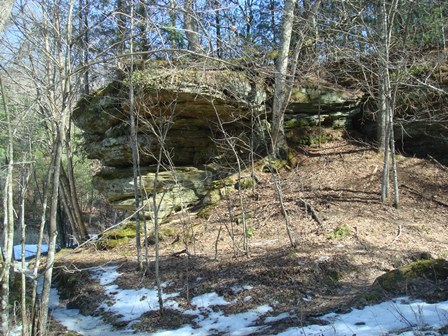Archaeology Periods
The following outline presents significant characteristics of the major periods of prehistory for the upper Kickapoo Valley and the surrounding region of southwestern Wisconsin. Paleo-Indian Tradition
10,000 B.C. – 7,000 B.C.
◾Glaciers recede north.
◾Rapidly-changing environment with tundra and spruce-fir forests transforms to a mosaic or conifer-deciduous forest and prairie as a result of the post-glacial warming trend.
◾Mastodon in the Kickapoo Valley and regionally woolly mammoth, probably giant beaver, bear, caribou, and possibly horse and camel thrive (by 9,000 B.C. they are all extinct).
◾People are migratory hunters, moving as small bands across the landscape.
◾Hunters use spears with distinctive lance-shaped chipped stone points thought to be used for thrusting and cutting rather than throwing. Archaic Tradition
7000 B.C. – 500 B.C.
◾The Archaic Tradition centers on the climax of the post-glacial warming trend (6000 B.C. to 2000 B.C.)
◾Generally, hunters modify spears to a form that is to be thrown using the atlatl or spear thrower. Projectile points from the District are most commonly side-notched (Raddatz) or have expanding stems (Durst).
◾People hunt mostly deer and elk, with increasing use of plant foods and early domestication of some plant types.
◾Formal cemeteries are created and individuals are buried with personal possessions indicating social ranking.
◾No Archaic cemeteries are known for this portion of the Kickapoo Valley.
◾The first period in which the Upper Kickapoo Valley is first intensively occupied. The number of sites increases, with rockshelters frequently occupied during the winter.
|
|
 Woodland Tradition
500 B.C. - A.D. 1500
◾First pottery in the archeological record.
◾Less frequent use of the rockshelters in the District.
◾Hunting and gathering, still the primary methods of acquiring food, are supplemented with domesticated plants such as corn and squash.
◾About A.D. 500, the bow and arrow come into use.
◾Burial of the dead in mounds is common by A.D. 100. Upper Mississippian Tradition
A.D. 1000 - A.D. 1650
◾Distinctive globe-shaped pottery vessels, usually shell-tempered (shell fragments mixed into the potter’s clay), with well-defined shoulders and a flaring rim.
◾Large, sprawling village complexes supported by intensive corn agriculture and supplemented by hunting.
◾Villages cluster in distinct localities (e.g., La Crosse and Pepin) separated by uninhabited lands.
◾There is very little evidence that Mississippian Tradition people used the Upper Kickapoo Valley, suggesting very brief stops during travel or resource procurement activities. |
|
|